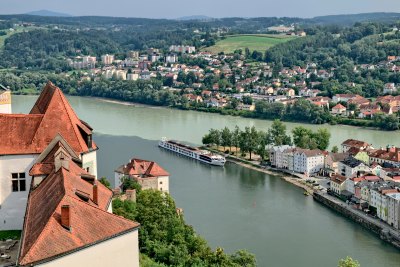 In Germany there are the sources of the second longest river in Europe, the Danube; it crosses a large part of southern Germany (from west to east), and then continues its long course through many other European countries, before flowing into the Black Sea.
In Germany there are the sources of the second longest river in Europe, the Danube; it crosses a large part of southern Germany (from west to east), and then continues its long course through many other European countries, before flowing into the Black Sea.The second river in terms of length, the Rhine, however, is of greater importance, given that it is widely used for the movement of goods, thanks to the fact that it is entirely navigable as far as the German stretch and up to its mouth in the North Sea in the neighboring Netherlands.
The other two main waterways, Elbe and Oder, cross eastern and northern Germany, with the first flowing into the North Sea shortly after passing through Hamburg, the city with the third European port by cargo tonnage, while the second never enters completely in Germany, but for a good stretch it marks the border with Poland.
The longest river that flows entirely on German territory is the Main, which originates in Bavaria and then continues for over 500 kilometers westwards, also bathing Frankfurt, just before entering the Rhine near Mainz.
| River | Length (km) | Length (mi) | Mouth | Federal States |
| Danube (1) | 2,858 km | 1,776 mi | Black Sea | Baden-Württemberg, Bavaria |
| Rhine (2) | 1,320 km | 820 mi | North Sea | Baden-Württemberg, Rhineland-Palatinate, Hesse, North Rhine-Westphalia |
| Elbe (3) | 1,094 km | 680 mi | North Sea | Saxony, Brandenburg, Saxony-Anhalt, Lower Saxony, Mecklenburg-Vorpommern, Schleswig-Holstein, Hamburg |
| Oder (4) | 866 km | 538 mi | Szczecin Lagoon | Brandenburg |
| Moselle (5) | 545 km | 339 mi | Rhine | Saarland, Rhineland-Palatinate |
| Main (6) | 527 km | 327 mi | Rhine | Bavaria, Baden-Württemberg, Hesse |
| Inn (7) | 510 km | 317 mi | Danube | Bavaria |
| Weser (8) | 451 km | 280 mi | North Sea | Lower Saxony, Hesse, North Rhine-Westphalia, Bremen |
| Saale | 413 km | 257 mi | Elbe | Bavaria, Thuringia, Saxony-Anhalt |
| Spree (9) | 382 km | 237 mi | Havel | Saxony, Brandenburg, Berlin |
| Ems | 371 km | 231 mi | North Sea | North Rhine-Westphalia, Lower Saxony |
| Neckar | 362 km | 225 mi | Rhine | Baden-Württemberg, Hesse |
| Havel | 334 km | 208 mi | Elbe | Mecklenburg-Vorpommern, Brandenburg, Berlin, Saxony-Anhalt |
| Ohre (10) | 316 km | 196 mi | Elbe | Bavaria |
| Werre | 300 km | 186 mi | Weser | Thuringia, Hesse, Lower Saxony |
| Isar (11) | 292 km | 181 mi | Danube | Bavaria |
| Mulde | 290 km | 180 mi | Elbe | Saxony, Saxony-Anhalt |
| Leine | 278 km | 173 mi | Aller | Thuringia, Lower Saxony |
| Aller | 260 km | 162 mi | Weser | Saxony-Anhalt, Lower Saxony |
| White Elster (12) | 257 km | 160 mi | Saale | Saxony, Thuringia, Saxony-Anhalt |
| Lech (13) | 256 km | 159 mi | Danube | Bavaria |
| Lusatian Neisse (14) | 254 km | 158 mi | Oder | Saxony, Brandenburg |
(1) The German stretch is 647 km, from the source of Donaueschingen in the Black Forest, up to a couple of kilometers after Passau, where it marks the border with Austria for about 20 km, before completely entering this country.
(2) German portion of 865 kilometers; for a very short stretch it enters Germany entirely in Constance, before marking the border several times with Switzerland and then with France and finally, in the last part of its course, with the Netherlands for just 8 km.
(3) It originates in the Czech Republic and enters Germany north of Decín, for a stretch of 727 km in German territory, up to its mouth.
(4) It never enters Germany entirely, but serves as a border with Poland for 179 kilometers.
(5) It originates in France, then marks the border between Luxembourg and Germany, before continuing on German soil, for a total of 242 km.
(6) It forms in the town of Kulmbach, in Bavaria, from the union of Red Main and White Main.
(7) It originates in Switzerland and later marks the border between Austria and Germany in two sections of the course; runs on German soil for a total of 218 km.
(8) It arises from the confluence of Fulda and Werra, considering the latter as a spring branch, the length is 751 Km.
(9) A few kilometers after the source it enters the Czech Republic for a short stretch of 700 meters; briefly marks Germany's border with this country on two occasions.
(10) Only the first 38 km of the course are in Germany, the rest in the Czech Republic.
(11) The first short section is in Austria; 263 km in German territory.
(12) The initial 10 km are in the Czech Republic, the remaining 247 in Germany.
(13) River that originates in Austria and runs through 170 km in Germany.
(14) The source is located in the Czech Republic; it never enters entirely in Germany, but first acts as a border with this country (for only about 1,400 meters) and then with Poland, for a total of 201 km.
German citizenship by descent through a great grandparent is possible for Americans with German ancestry.
